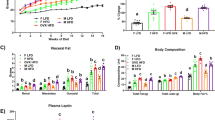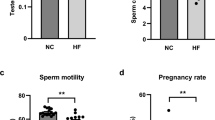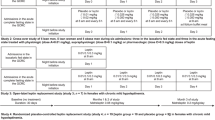Abstract
Background:
Obesity is strongly associated with female infertility, but the mechanisms underlying this relationship are largely unknown.
Methods:
We investigated the effect of increasing dietary fat percentage upon body mass, hypothalamic neuropeptide gene expression, adipose hormone secretion and fertility in females of the inbred mouse strains C57BL/6J and DBA/2J. To assess the effect of obesity independent of dietary influence, we also compared these parameters in wild-type female C57BL/6J mice to those congenic for the obesogenic mutations ob/ob and Ay/a.
Results:
After 24 weeks, rather than exhibiting an obese, leptin-resistant phenotype like their female DBA/2J counterparts, wild-type female C57BL/6J mice remained lean, fertile and manifested increased hypothalamic LEPR-B expression. Although both mutant genotypes were associated with obesity and subfertility, ob/ob mice demonstrated significantly increased hypothalamic LEPR-B expression, whereas Ay/a mice had a significant reduction. Interestingly, wild-type female C57BL/6J mice were noted to manifest significantly higher and lower levels of adiponectin and tissue plasminogen activator inhibitor-1 (tPAI-1), respectively, than weight-matched wild-type female DBA/2J mice.
Conclusions:
We conclude that (1) resistance to the obese-infertile phenotype in female C57BL/6J mice is associated with increased hypothalamic leptin receptor expression and alterations in adipokine levels consistent with decreased adipose tissue inflammation and (2) that long-standing hyperleptinemic obesity in mice is associated with a downregulation of the hypothalamic leptin receptor.
This is a preview of subscription content, access via your institution
Access options
Subscribe to this journal
Receive 12 print issues and online access
$259.00 per year
only $21.58 per issue
Buy this article
- Purchase on Springer Link
- Instant access to full article PDF
Prices may be subject to local taxes which are calculated during checkout







Similar content being viewed by others
References
Frederich RC, Lollmann B, Hamann A, Napolitano-Rosen A, Kahn BB, Lowell BB et al. Expression of ob mRNA and its encoded protein in rodents. Impact of nutrition and obesity. J Clin Invest 1995; 96: 1658–1663.
Frederich RC, Hamann A, Anderson S, Lollmann B, Lowell BB, Flier JS . Leptin levels reflect body lipid content in mice: evidence for diet-induced resistance to leptin action. Nat Med 1995; 1: 1311–1314.
Considine RV, Sinha MK, Heiman ML, Kriauciunas A, Stephens TW, Nyce MR et al. Serum immunoreactive-leptin concentrations in normal-weight and obese humans. N Engl J Med 1996; 334: 292–295.
Carlsson B, Lindell K, Gabrielsson B, Karlsson C, Bjarnason R, Westphal O et al. Obese (ob) gene defects are rare in human obesity. Obes Res 1997; 5: 30–35.
Fantuzzi G . Adipose tissue, adipokines, and inflammation. J Allergy Clin Immunol 2005; 115: 911–919; quiz 920.
Weisberg SP, McCann D, Desai M, Rosenbaum M, Leibel RL, Ferrante Jr W . Obesity is associated with macrophage accumulation in adipose tissue. J Clin Invest 2003; 112: 1796–1808.
Tortoriello DV, McMinn J, Chua SC . Dietary-induced obesity and hypothalamic infertility in female DBA/2J mice. Endocrinology 2004; 145: 1238–1247.
Lansang MC, Williams GH, Carroll JS . Correlation between the glucose clamp technique and the homeostasis model assessment in hypertension. Am J Hypertens 2001; 14: 51–53.
Katz A, Nambi SS, Mather K, Baron AD, Follmann DA, Sullivan G et al. Quantitative insulin sensitivity check index: a simple, accurate method for assessing insulin sensitivity in humans. J Clin Endocrinol Metab 2000; 85: 2402–2410.
El-Haschimi K, Lehnert H . Leptin resistance – or why leptin fails to work in obesity. Exp Clin Endocrinol Diabetes 2003; 111: 2–7.
Huang XF, Han M, South T, Storlien L . Altered levels of POMC, AgRP and MC4-R mRNA expression in the hypothalamus and other parts of the limbic system of mice prone or resistant to chronic high-energy diet-induced obesity. Brain Res 2003; 992: 9–19.
Huang XF, Han M, Storlien LH . The level of NPY receptor mRNA expression in diet-induced obese and resistant mice. Brain Res Mol Brain Res 2003; 115: 21–28.
Ravinet Trillou C, Arnone M, Delgorge C, Gonalons N, Keane P, Maffrand JP et al. Anti-obesity effect of SR141716, a CB1 receptor antagonist, in diet-induced obese mice. Am J Physiol Regul Integr Comp Physiol 2003; 284: R345–R353.
Lin S, Storlien LH, Huang XF . Leptin receptor, NPY, POMC mRNA expression in the diet-induced obese mouse brain. Brain Res 2000; 875: 89–95.
Agardh CD, Agardh E, Hultberg B, Ahren B . Long-standing hyperglycemia in C57BL/6J mice does not affect retinal glutathione levels or endothelial/pericyte ratio in retinal capillaries. J Diabetes Complications 2000; 14: 146–153.
De Taeye B, Smith LH, Vaughan DE . Plasminogen activator inhibitor-1: a common denominator in obesity, diabetes and cardiovascular disease. Curr Opin Pharmacol 2005; 5: 149–154.
Fay WP, Shapiro AD, Shih JL, Schleef RR, Ginsburg D . Brief report: complete deficiency of plasminogen-activator inhibitor type 1 due to a frame-shift mutation. N Engl J Med 1992; 327: 1729–1733.
Chorostowska-Wynimko J, Skrzypczak-Jankun E, Jankun J . Plasminogen activator inhibitor type-1 controls the process of the in vitro sprout formation. J Physiol Pharmacol 2004; 55 (Suppl 3): 49–56.
Ma LJ, Mao SL, Taylor KL, Kanjanabuch T, Guan Y, Zhang Y et al. Prevention of obesity and insulin resistance in mice lacking plasminogen activator inhibitor 1. Diabetes 2004; 53: 336–346.
Kadowaki T, Yamauchi T . Adiponectin and adiponectin receptors. Endocr Rev 2005; 26: 439–451.
Yamauchi T, Kamon J, Waki H, Murakami K, Motojima K, Komeda K et al. The mechanisms by which both heterozygous peroxisome proliferator-activated receptor gamma (PPARgamma) deficiency and PPARgamma agonist improve insulin resistance. J Biol Chem 2001; 276: 41245–41254.
Qi Y, Takahashi N, Hileman SM, Patel HR, Berg AH, Pajvani UB et al. Adiponectin acts in the brain to decrease body weight. Nat Med 2004; 10: 524–529.
Acknowledgements
This work has been supported by a Women's Reproductive Health Research Scholarship, NIH 5 K12 HD001275 (DVT).
Author information
Authors and Affiliations
Corresponding author
Rights and permissions
About this article
Cite this article
Tortoriello, D., McMinn, J. & Chua, S. Increased expression of hypothalamic leptin receptor and adiponectin accompany resistance to dietary-induced obesity and infertility in female C57BL/6J mice. Int J Obes 31, 395–402 (2007). https://doi.org/10.1038/sj.ijo.0803392
Received:
Revised:
Accepted:
Published:
Issue Date:
DOI: https://doi.org/10.1038/sj.ijo.0803392
Keywords
This article is cited by
-
Female infertility: which role for obesity?
International Journal of Obesity Supplements (2019)
-
The ‘beneficial’ adipokines in reproduction and fertility
International Journal of Obesity (2008)
-
Obesity in C57BL/6J mice is characterized by adipose tissue hypoxia and cytotoxic T-cell infiltration
International Journal of Obesity (2008)
-
Extreme Obesity Reduces Bone Mineral Density: Complementary Evidence from Mice and Women*
Obesity (2007)



